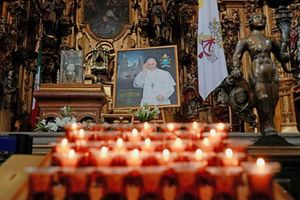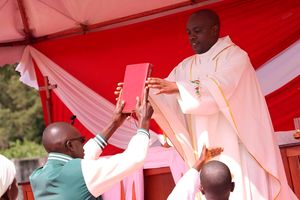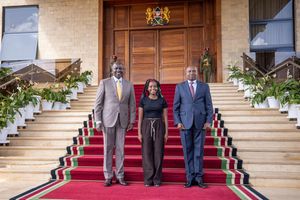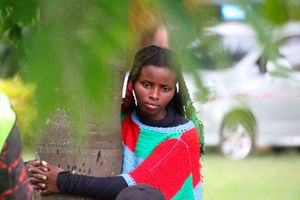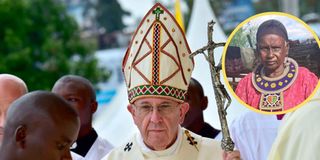
Pope Francis at the University of Nairobi grounds on November 26, 2015 wearing a beaded mitre. Inset: Lydia Melde Letipila, who made the Pope's mitre.
In the dusty Munanda Village in Baragoi, Samburu County, 72-year-old Lydia Melde Letipila sits outside her humble manyatta, squinting at a handful of brightly coloured beads.
Despite her failing eyesight, Ms Letipila’s hands still retain the rhythm of sewing, threading, stitching and weaving intricate beadwork patterns — an art she has mastered over decades.
“Nowadays, I struggle to see clearly because my eyesight is becoming poor,” she says. “But I can still sew very well and I remember every pattern and know each colour used.”
At first glance, she might appear like any other woman from Samburu doing beadwork.
But she holds a rare distinction as she is the woman who crafted the mitre—a distinctive headgear for top church officials—worn by Pope Francis during his historic visit to Kenya in 2015.

Pope Francis at the University of Nairobi grounds on November 26, 2015 wearing a beaded mitre. Inset: Lydia Melde Letipila, who made the Pope's mitre.
A mother of seven and now a widow, Ms Letipila is known across Baragoi for her beadwork expertise. Over the years, she has crafted necklaces, beaded ties, belts and bangles using locally sourced materials and traditional designs.
Her journey to global recognition began in 2001 when the Catholic Diocese of Maralal asked her to make a mitre for Bishop Virgilio Pante, who was being installed at the time.
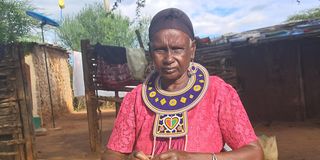
Lydia Melde Letipila,72, beads a necklace at her home at Munanda village in Baragoi, Samburu North. Ms Letipila used a traditional goatskin, beads and a soft linen to make the mitre worn by Pope Francis during his historic visit to Kenya in 2015.
Bishop Pante, who later wrote in his memoirs that working in northern Kenya was “love at first sight”, was deeply moved by her talent and became one of her biggest admirers and friends.
“Bishop Pante is a very good friend. He even gave me several orders from other bishops in the country,” she says with a smile.
Then came 2015, the turning point when Bishop Pante returned to Baragoi with a special request: Pope Francis was scheduled to visit Kenya and the bishop wanted Ms Letipila to craft a mitre for the Holy Father.
“It was such a big moment for me as a woman from Baragoi as I had never imagined that my beadwork would reach the world stage,” she says.
Using traditional goatskin, soft linen and her signature bead patterns, she designed a mitre that merged Samburu culture with Catholic symbolism. Even before Pope Francis landed in Kenya, the mitre was presented to him in Rome, Italy, during the ad limina apostolorum (“to the thresholds of the Apostles”) meeting with Kenyan Catholic bishops ahead of his African tour.
Pope Francis wore Ms Letipila’s handcrafted mitre in November 2015 at the University of Nairobi grounds during a papal mass, which was broadcast to millions around the world.
The mass, held amid a heavy downpour, drew tens of thousands of Catholic faithful, including retired President Uhuru Kenyatta.
But few knew that the ceremonial headgear worn by the Pope was made by a woman from the remote Samburu North.
“I took about a month to complete the mitre. When I finished, Bishop Pante asked me to make a second one as a backup, just in case,” she says.
Since then, Ms Letipila has made mitres for many other clergymen across and beyond Samburu County. Among them is Bishop Jacob Lesuuda, the first bishop of the Anglican Diocese of Maralal.
Her path to beadwork began out of necessity. Like many pastoralists in the region, she lost nearly all her livestock to drought, a frequent hardship in the arid landscape.
“I earned Sh10,000 from crafting a single mitre. Beadwork became my only source of income after I lost my animals,” she says.
Although she never got to meet Pope Francis physically, Ms Letipila prays that his soul rests in eternal peace.

